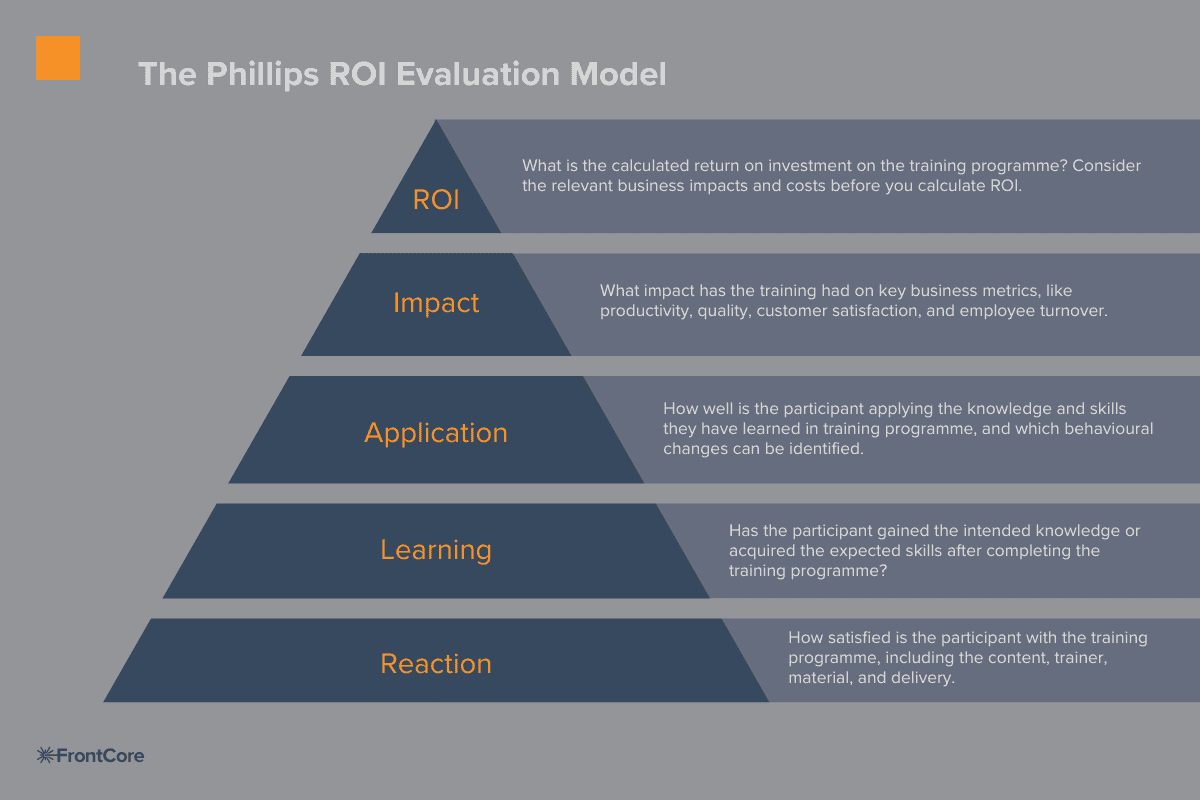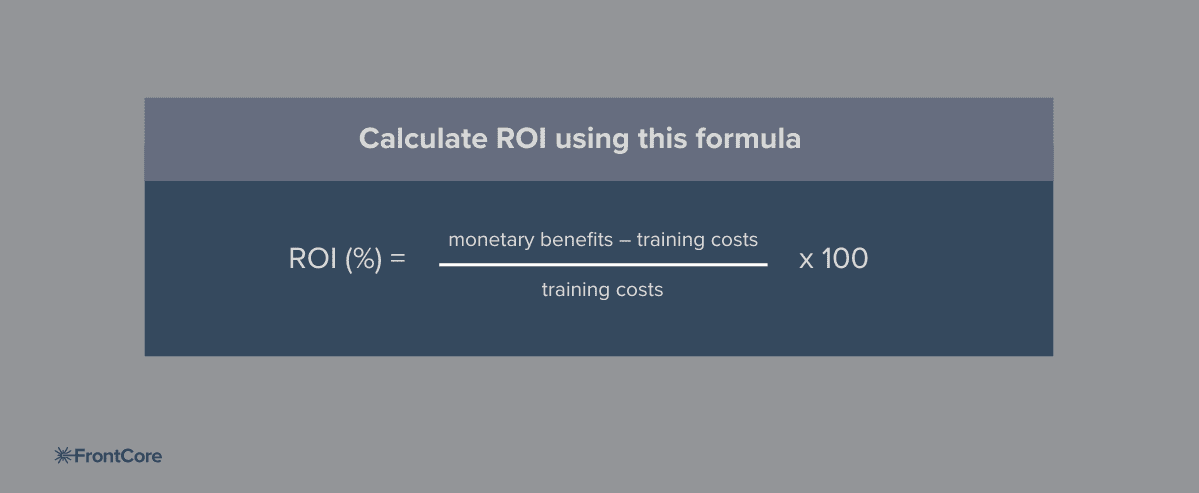The Phillips ROI model explained: Key to any training provider

The Phillips ROI model is another model of evaluation that measures training effectiveness, which is perhaps the number one performance indicator for your training offer. It builds from the Kirkpatrick model of evaluation, which demonstrates training evaluation in four steps. The Phillips ROI model adds an extra step, which, as the name suggests, considers the return on investment (ROI). In this article, we will delve into all these steps and explore how useful it can be to consider ROI in the process.
What is the Phillips ROI model?
The Phillips ROI model is a training evaluation model which considers the effectiveness of a training offer based on 5 steps. This enables you to evaluate any given training programme based on the learning outcome the course participants realise and the perceived level of value they get. The key to the Phillips ROI model, that sets it apart from other models of training evaluation, is the consideration of return on investment. This monetary value is an important metric not only to the course participant who buys the training programme, but also to you as a training provider.
The financial value of training programmes
Jack Phillips wanted to explore the financial value of training programmes, and in 1970, he published his book «Return on Investment in Training and Performance Improvement Programs». In the book, he addresses Don Kirkpatrick’s evaluation model and sets forth another approach to measuring training effectiveness. He tweaked the four steps in the Kirkpatrick model and added the step on ROI. You can read about this approach in detail in this PDF document published by the ROI Institute.
Another model of training evaluation
We have also explained how the Kirkpatrick model works and how it can be useful for you as a training provider. Explore the different steps that allow you to evaluate the learning outcomes of your courses.
Read the guide to the Kirkpatrick model
This is why you should care about measuring effectiveness
You may be wondering why you should apply this model to your own training programmes or even consider training evaluation when you are building your training company. This is a natural question to ask, and luckily, there are many reasons why it is helpful to structure your training offer based on input from your participants.
For your course programmes
- You are able to identify whether your training offer meets the learning objectives that your target audience has, both to attract new customers and keep existing customers engaged.
- Based on feedback from your participants, you are able to implement changes and overall boost the quality of your course offerings.
For your participants
- You can easily demonstrate value to potential customers by showcasing your willingness to adapt to feedback, as well as ensuring that current participants feel included and considered in the course programme design.
- You can identify training programme gaps and implement changes that will increase participant engagement.
- It allows any L&D department to make a number of the actual benefits of a training programme and demonstrate the effect that it has on productivity and profitability.
For your business longevity
- It allows you to align your training offerings with the company goals. This makes it easier to design a course format that aligns with other critical KPIs or business metrics.
- You are able to justify investment in training based on ROI data. This is key to demonstrating value, which in turn will ensure a healthy business.
Also read: How to create an online course?
The Phillips ROI model illustrated
The five levels of the Phillips evaluation model
- Reaction: It measures how satisfied each participant is with the training offer.
- Learning: It assesses the knowledge or skills they have gained in the course.
- Application: It evaluates the extent to which each participant applies what they have learned in practice.
- Impact: It measures the effect that the training programme has had on business outcomes.
- ROI: It compares the monetary benefits of the training to its costs, as well as calculating the overall return on investment.
Levels in the Phillips model
Level 1: Reaction
- Objective: To identify the participants’ overall satisfaction with the course.
- What to measure: How would the participants rate the quality of the content, trainer, material, and delivery.
- Method: Surveys, feedback forms, and questionnaires.
Level 2: Learning
- Objective: To determine whether the participants have gained the intended knowledge or skills.
- What to measure: The level of knowledge gained or new skills acquired through the training programme.
- Method: Pre- and post-assements or quizzes.
Level 3: Application
- Objective: To evaluate how well the participants are applying what they have learned in their professional or personal life.
- What to measure: The behavioural changes, how often they apply skills, or if there are any barriers to implementing what they have learned.
- Method: Follow-up surveys, interviews, or observations (weeks or months after training).
Level 4: Impact
- Objective: To measure the impact that training has had on key business metrics.
- What to measure: Consider metrics like productivity, quality, customer satisfaction, and employee turnover.
- Method: Data analysis based on performance pre and post training programme.
Level 5: ROI
- Objective: To calculate the financial return on investment (ROI).
- What to measure: The value of the training programme in financial terms.
- Method: Read our step-by-step guide next.
Step-by-step how to calculate training ROI
Translate business impact
The first step is to translate the business impact into financial terms. This would for example entail defining the monetary value of increased productivity.
Calculate costs
Second, you must calculate the total costs of the training programme. This includes materials, software, fees, participants time, and more.
Calculate ROI
Interpret ROI
After you have calculated the ROI, you must interpret the results. A positive ROI indicates that the financial benefits of the training programme outweighs its costs. In this process, it is important to isolate the effects of training. It is critical to disregard any business impacts that are not directly linked to the training programme.
From here, you should report the results of the analysis. Use the information to make even more informed decisions and be transparent with stakeholders about the results.
As a training provider, you should use the Phillips ROI model
- It enables to evaluate your training offer and programmes comprehensively, both in terms of participant satisfaction and business profitability
- You are able to quantify the financial impact of your training programmes, which not only is important for selling your course and attracting customers, but key to securing investments from various stakeholders.
- Using the Phillips ROI model, you have a structured framework to make informed decisions on every aspect of your training business.
Apply the evaluation module in the FrontCore TMS to your benefit
There are many tasks to keep track of as a training provider. To streamline these responsibilities, you should use training management software that allows for easier course administration. The FrontCore Training Management System is a one-stop solution for exactly that, while also offering marketing and sales tools you can use to create engagement around your course.
Did you like this article? Don't forget to share it:

About FrontCore
Over 3700 training providers use solutions from FrontCore – and that’s not without reason. FrontCore is one of Norway’s leading competence environments within cloud based systems for Training Management, Learning Management and Webmarketing. With over 23 years of experience from the training industry and our finger on the market pulse continuously, we help course and training providers achieve more efficiency and higher revenue.
Products

Related articles
Guide: How to start a training business
Thinking of starting your own training company in the UK? Get all the essential steps, insights, and expert tips in this complete guide—plus how the right tools can help you succeed from day one. Ready to launch your training business?
Kirkpatrick model: How to use it in your training business
Curious about how to measure your training’s true impact? Discover how the Kirkpatrick Model can help you improve your courses, boost participant satisfaction, and achieve real business results.
Employee Training: The Importance and Value of Investing in Workforce Development
Employee training boosts individual performance and company growth. Learn how the right programs can increase job satisfaction, engagement, and profit. Explore various training methods that empower employees to thrive. Ready to invest in your team’s future?











0 Comments